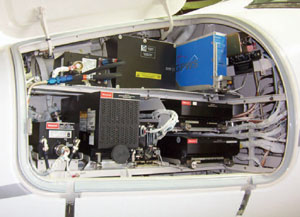
Features
Avionics
Upgrading Your Avionics
It’s a decision that requires some serious thought
September 28, 2007 By James Careless
 Whether you’re upgrading your radio communications or adding new GPS
Whether you’re upgrading your radio communications or adding new GPS
capabilities, nothing spruces up an aircraft like new avionics But
buying the right avionics takes more than an appetite for neat tech
toys and a fat wallet. It requires a knowledge of what’s available, and
what’s right for your aircraft.
WHAT PILOTS ARE BUYING
To
get an idea of what’s out there, it helps to know what people are
buying. In a word, the answer is GPS: Pilots flying recreational,
business, and even small commercial aircraft are putting their money in
location- tracking equipment.
Small wonder; by using GPS
locational systems equipped with colour LCD displays, pilots can know
where they are at all times. In addition, sophisticated GPS avionics
typically integrate a host of useful functions into one small package.
For
instance, Garmin’s GNS 530 incorporates a WAAS-upgradeable IFR GPS,
Com, VOR, LOC, and glide-slope with a colour moving map; displayed on
the unit’s 5" LCD panel. Meanwhile, the GNS 530’s Jeppesen database
(that can be updated with a frontloading data card) contains
information on all airports, VORs, NDBs, Intersections, FSS, Approach,
DPs/STARs and SUA information.
The Garmin GNS 530, plus the
company’s GNS 430 and GNS 480 multifunction GPS units, are powerful
navigation tools. “Most of the avionics upgrades we are doing today are
installing 430s, 480s, and 530s,” says David M. Dunn, owner/ manager of
Victoria Avionics in Sidney, BC.
For business and commercial
pilots, TAWS (Terrain Awareness and Warning System) and TCAS (Traffic
Alert and Collision Avoidance System) avionics are popular purchases.
“These
upgrades are very much regulation-driven,” notes Don Pollock, director
of sales/engineering for Pacific Avionics in Richmond, BC. “Although
the FAA is currently turning a blind eye to Canadian aircraft flying
without this equipment in US airspace, this could change at any time.
Meanwhile, we expect Canada to implement TAWS and TCAS equipment
requirement regulations by 2007.”
Satellite telephones are a
third big seller. Again, this trend isn’t surprising, given that the
Globalstar and Iridium satellite telephone systems provide nearly
planet-wide coverage. “For those flying lighter aircraft, there are
portable/removable satellite phones available that can help them stay
in touch with the ground at a very affordable price,” Pollock says.
“Meanwhile, heavier aircraft can have these systems installed in their
cockpits, for convenient, reliable communications no matter where they
are.”
CHOOSING THE RIGHT STUFF
Before you rush out and
buy the latest, greatest new avionics, take a careful look at your
aircraft. Does the airframe have much life left in it? Is the wiring in
good shape? If not, then think twice about adding new avionics because,
“there’s not much point spending $200K on a worn-out aircraft,” says
Imam Cella, general manager of Aircraft Electronics at Toronto City
Centre Airport.
Next, ask yourself how long you intend to keep
this aircraft. If you are planning to sell, you could run into some
difficulties. “Adding avionics to an aircraft is like adding a swimming
pool to your house,” Cella says. “Chances are the new owner won’t pay
you enough to cover the cost of the addition.”
Other points to
consider: Is there room on your panel to accommodate the new avionics?
If not, are you willing (and able) to sacrifice an existing component
to make space, or should the new component be installed elsewhere in
the cockpit? If you do install it elsewhere, will the new avionics be
easy to see and use? Or will they make your display more confusing to
use during flight?
Once you’ve answered these questions, “it is
time to make a wish list,” Cella says. “You should start by listing any
upgrades needed to meet new government requirements and satisfy safety
concerns. Only then should you start adding new avionics that aren’t
essential.”
Talk to people who are already using the avionics
that interest you. They can provide you with unbiased opinions. Stay on
top of technology trends – this year’s hot avionics can turn into next
year’s has-been. Finally, give some thought to what could happen should
you lose power during flight: Will the new component simply shut down,
or does it have some kind of backup power source built into its
architecture?
These are the kinds of things you need to know in
order to make an informed decision. Having this information will help
you make the right choice for your budget and your aircraft.